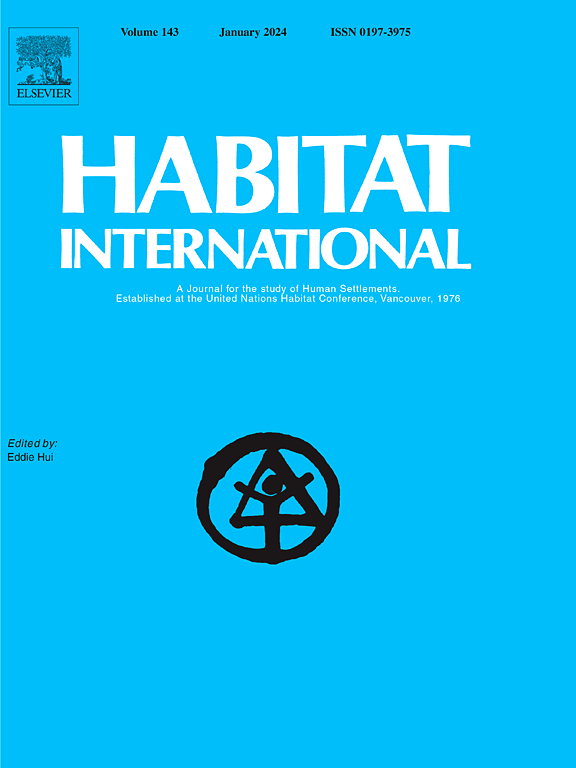Aspirations versus reality: Factors influencing the vertical social mobility of urban Roma mothers living in extreme poverty
IF 6.5
1区 经济学
Q1 DEVELOPMENT STUDIES
引用次数: 0
Abstract
As a result of historical racism and stigmatization for Roma people, living their lives spatially segregated in extreme poverty, opportunities for individual, vertical social mobility are limited by a myriad of structural factors. In addition to this stark reality, no studies deal specifically with the vertical social mobility of extremely poor, stigmatized and segregated urban Roma mothers. The present study aims to contribute to filling this research gap by raising the following research question: What kind of aspirations do extremely poor, stigmatized and segregated urban Roma mothers have in relation to social mobility and, what are the factors that influence their (lack of) vertical mobility? Long term qualitative observations supplemented by semi-structured interviews were used in a Hungarian urban context to answer this research question. Our results indicate that aspirations of vertical social mobility among urban Roma mothers is not related to leaving class behind, and all that implies, but to provide basic material security for their children. However, this aspiration should still be realized in an essentially hostile environment characterized by racist everyday relations in the illiberal nation-state of Hungary. As a result, a number of factors that are linked to the core institutions of social reproduction limit vertical mobility, supplemented by certain internal norms of segregated Roma communities. Meanwhile, vertical mobility might also lead to loss of community ties and thus important material and emotional resources. Within such a context, Roma mothers' efforts towards vertical social mobility are a dramatic struggle. Our results reinforce the understanding that social mobility that indeed serves social justice should be considered as a collective endeavour that improves the situation of entire communities, instead of individualizing responsibility for one's own social position – especially if these “ones” are historically stigmatized and othered.
愿望与现实:影响极端贫困城市罗姆母亲纵向社会流动的因素
由于历史上对罗姆人的种族主义和污名化,他们的生活在空间上被隔离在极端贫困中,个人纵向社会流动的机会受到无数结构性因素的限制。除了这一严峻的现实之外,没有研究专门涉及极端贫困、被污名化和被隔离的城市罗姆母亲的垂直社会流动性。本研究旨在通过提出以下研究问题来填补这一研究空白:极端贫困、被污名化和被隔离的城市罗姆母亲在社会流动性方面有什么样的愿望,以及影响她们(缺乏)垂直流动性的因素是什么?长期定性观察辅以半结构化访谈在匈牙利城市背景下回答这个研究问题。我们的研究结果表明,城市罗姆母亲对垂直社会流动的渴望与脱离阶级无关,这意味着什么,而是为她们的孩子提供基本的物质保障。然而,这一愿望仍应在匈牙利这个不自由的民族国家以种族主义日常关系为特征的基本上充满敌意的环境中实现。因此,与社会再生产的核心机构有关的一些因素限制了纵向流动,再加上被隔离的罗姆人社区的某些内部规范。同时,垂直流动也可能导致社区联系的丧失,从而失去重要的物质和情感资源。在这样的背景下,罗姆母亲为垂直社会流动所做的努力是一场戏剧性的斗争。我们的研究结果强化了这样一种认识,即真正服务于社会正义的社会流动应该被视为一种改善整个社区状况的集体努力,而不是为自己的社会地位承担个人责任-特别是如果这些“人”在历史上被污名化和其他。
本文章由计算机程序翻译,如有差异,请以英文原文为准。
求助全文
约1分钟内获得全文
求助全文
来源期刊

Habitat International
Multiple-
CiteScore
10.50
自引率
10.30%
发文量
151
审稿时长
38 days
期刊介绍:
Habitat International is dedicated to the study of urban and rural human settlements: their planning, design, production and management. Its main focus is on urbanisation in its broadest sense in the developing world. However, increasingly the interrelationships and linkages between cities and towns in the developing and developed worlds are becoming apparent and solutions to the problems that result are urgently required. The economic, social, technological and political systems of the world are intertwined and changes in one region almost always affect other regions.
 求助内容:
求助内容: 应助结果提醒方式:
应助结果提醒方式:


